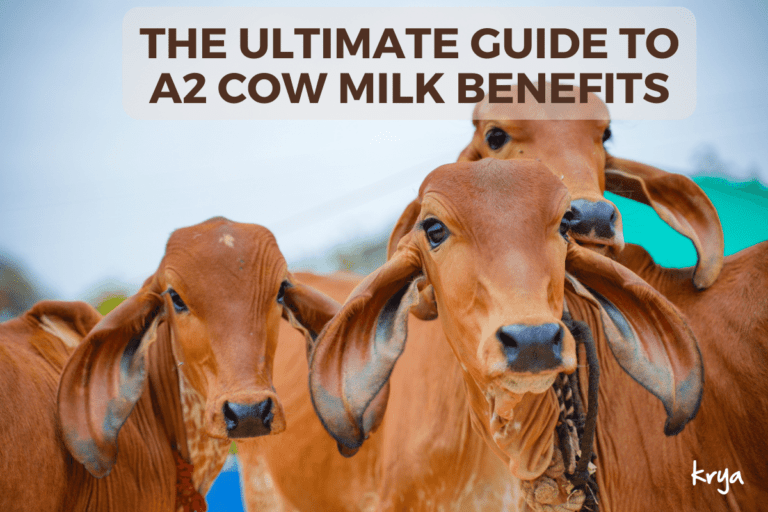
Cow’s milk is an important food in Ayurveda. Regular intake is said to improve ojas, tejas, build good dhatu and positively impacts physical and mental health and nutrient availability in the body. However today we get many varieties of cow’s milk. Are these all the same? What are the a2 cow milk benefits for us? In this article we analyze milks from an ayurvedic perspective . What Milk is widely available in India today? The predominant, widely available milk in India is processed, homogenized, pasteurized milk sourced from large cooperatives and conglomerates. They follow a collection + aggregation model. Here Milk is sourced from small dairy farmers with any breed of cow or buffalo, mixed together, homogenized to follow government standards of fat percentage and then sold as toned milk, full fat milk, etc. Which in turn use a mixture of own milk and aggregated milk. This is the case for all major cooperative dairy conglomerates across India. Problems with Commercial Mixed / A1 Milk type • Milk is sourced from different kinds of daily cattle and mixed together: so we have desi (A2), foreign (jersey – A1), hybrid (desi+jersey), buffalo, and sometimes goats milk being mixed together. The properties of each of these are different and will have a different effect on the body. Depending upon the mixture we get, the body may accept it better or it may not. • As Dairy farmers are rewarded for fat percentage of Milk (higher cost paid for higher milk fat), they are incentivized to replace lean indigenous breeds with foreign breeds which are naturally high in fat. Again to conserve milk fat, they restrict the animal’s movement and can feed the Animal high fat and unsuitable diet in order to extract high fat milk. • Unnatural, cruel dairy farming practices: To extract maximum yield from […]

A common question we get asked at Krya is about healthy eating timings & habits to follow and meal choices at each time. Today, the media is charged with advice on nutrition and the importance of developing healthy eating habits. Often, these so-called studies also become quite contradictory, and we naturally start looking for some genuine and time tested guidance on on ahara (food) and ahara niyama (dietary practices to observe). A key part of ahara niyama (or healthy eating habits) in Ayurveda is to identify the proper/healthy time to eat. This influences our capacity to digest food and extract nutrients from the food. In fact, choosing the correct time to eat each meal has the same effect on our health as choosing what to eat. In other words, we should spend the same amount of time planning when to eat as planning what to eat. In this post, we are going to see why Ayurveda pays so much attention to meal timing and how this is a key part of developing healthy eating habits. Planning healthy eating schedule: Different doshas influence different dayparts Ayurveda tells us that each day is divided into 4-hour dayparts. Each of these dayparts is connected to the slow rise, peaking, and then falling of a particular dosha in our body. The strength of the surge in the dosha depends upon the movement of the Sun. For example, if there is sunshine during the kapha period, the effect of kapha will be slightly reduced. Similarly, if there is good sunshine, say during a pitta part of the day, pitta will be much more aggravated due to the influence of the Sun. In order to take advantage of these natural surges in a particular dosha, we are advised to do certain activities during certain parts of […]
As we had written in Part 1, , many Ayurvedic rules on eating for good health, do not go with modern notions on health and nutrition. In fact, they seem contrarian and sometimes weird or even “unscientific” as per modern and often western expectations. However, as I have always maintained, good health reflects in great skin and hair. At krya we get many queries every day on tackling skin & hair care problems, which cannot be solved with the just use of external products alone, so we do end up gently nudging people to take a second look at their diet and lifestyle. So here is part 2 of my post on eating sensibly according to Ayurveda. As with all new information, please read this with an open mind. IMPORTANT NOTE :This article does NOT discuss the ethical consideration behind these food choices as some of the Ayurvedic prescriptions use animal derived products. At this point of time, I am simply talking about how Ayurveda analyzes each food choice in terms of its dosha and how it would impact human health alone. 1. Ayurveda follows a holistic approach to eating. There is no measurement of micro nutrients or break up of food into the terms we measure today like protein, carbohydrates, vitamins, minerals etc. Instead, Ayurveda and all traditional medicine talks about eating a balanced meal. And is concerned about eating local and seasonal food that is right for each dosha type. This cannot be compressed into a simple diet chart but has to be worked out according to the needs of the individual, their current state of health and the environment they live in and the nature of their work, etc. So for example, the diet prescribed for me, a Pitta-kapha type would consist of foods that are cooling but […]

If you are suffering from a visible Pitta imbalance like premature greying, acne outbreaks, then a Pitta balancing diet can help holistically heal your condition. Ayurveda believes in following a holistic approach to understanding skin and hair issues. Hair and skin reflects the body’s state of balance. Diet, emotional well being, quality of sleep, quality of daily Vyayama (exercise) all affect the body. These factors create changes in the subtle alignment of doshas in our body. This reflects in the quality of our skin or hair. Pitta dosha: qualities and life stage Pitta is “snigdha” (oily), “teekshna” (sharp), “ushna” (hot), “laghu” (light) “vishra” (mal-odourous), “sara“ ( flowing / laxative), and “drava” (liquid). Hence when we have Pitta aggravation in our body, we could experience sharp discomfort in the abdomen, diarrhea, gastritis, temper flares, strong body odour, high sweating, oiliness on hair and skin, etc. We could also develop acne flare ups, experience premature greying & also hair thinning. Ayurveda tells us that every lifestage is dominant in a certain dosha. Middle age, i.e. 30 – 60 years is considered Pitta dominant lifestage. In this age period, we naturally tend to harness and utilise Pitta’s qualities to help us focus on our career, manage our responsibilities, etc. Hence at this stage, we become even more sensitive to Pitta aggravation. Pitta aggravating foods: We had written earlier in detail about foods that trigger or aggravate Pitta in the body. This includes fermented foods, salty foods, spicy foods, and sour foods. We have a pretty detailed list of don’ts in the earlier blog post. This list includes commercial packaged RTE foods which are high in hidden salts and imported delicacies like Greek yoghurt, tahini sauce and hummus. Consumption of these foods is tolerable when our doshas in balance. At this time, Pitta […]
. Our skin and hair’s health depends on what we eat. Some foods can nourish and heal us. Other foods can throw us off balance and aggravate our doshas. This post will explore foods that aggravate and increase Pitta dosha.…
We spoke about open pores and oily skin yesterday and we looked at how they are variously approached by cosmetic science, dermatology and Ayurveda. We then looked at the role of Pitta dosha and how it influences oiliness on skin,…




